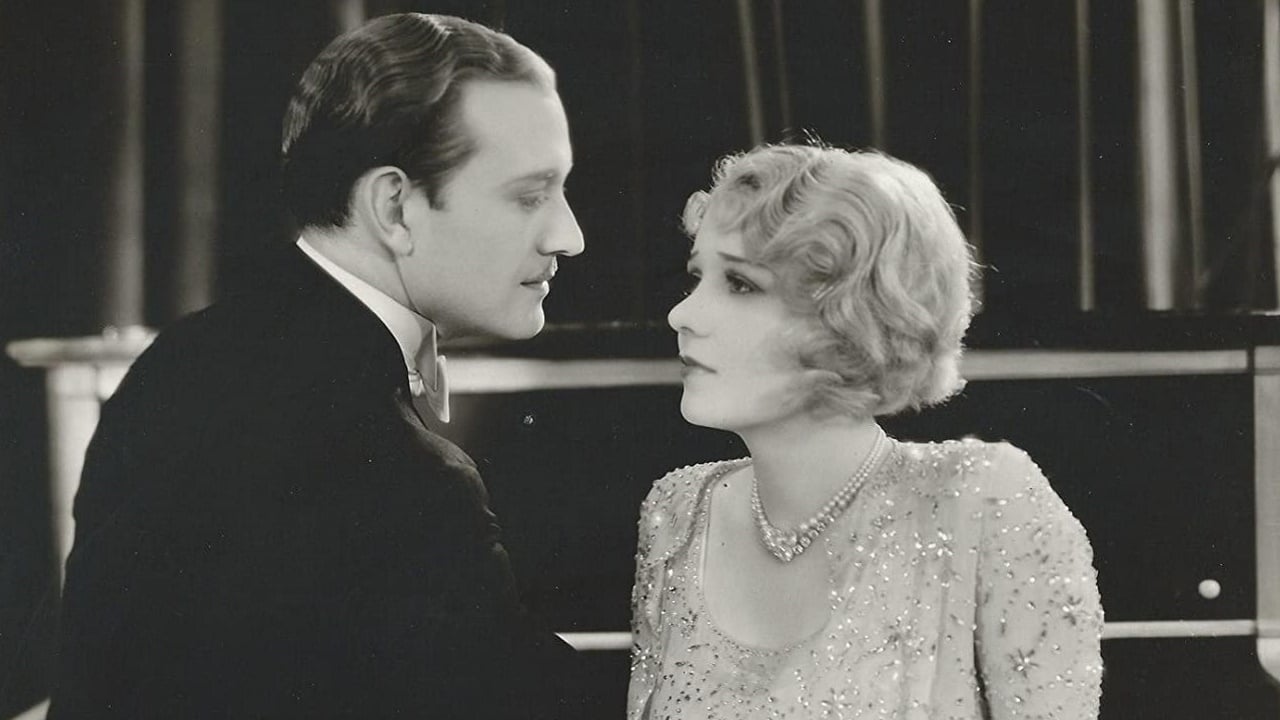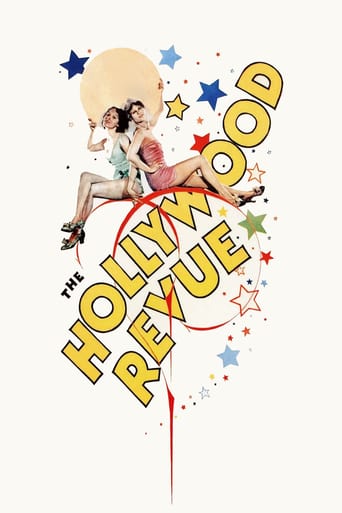LouHomey
From my favorite movies..
Freaktana
A Major Disappointment
Abegail Noëlle
While it is a pity that the story wasn't told with more visual finesse, this is trivial compared to our real-world problems. It takes a good movie to put that into perspective.
Billy Ollie
Through painfully honest and emotional moments, the movie becomes irresistibly relatable
richspenc
I actually rate this film about a 6 and a half, but I decided to round it off to a 7. My title up above for this film is my feelings for it in a nutshell. Where I said a good look at roaring 20s music, I meant some roaring 20s music was the kind of music in this film. The other kind of popular 1920s music was all the jazz and ragtime from that era. This film "Hollywood revue" is not a story and has no plot. It's a long stretch of then popular songs and dances. I read somewhere that people complained about some of the first few films with sound in the late 1920s being all music and no story, and that's why starting in the early 1930s musicals had a story with funny and interesting speaking parts as well as songs ("Footlight parade", "Dames", "42nd St" and the Gold diggers films are still my favorites). I've also read, however, that people back then loved the musical numbers and really enjoyed most sound films in general whether stories or musicals since it was all such a brand new novelty and exciting. That's the one I believe more. I didn't like this as much as some of the great films that were to come in the next following years, but there were a number of songs and numbers that I really did like. First, the 1920s version of "Singing in the rain". It was pretty good although not my favorite version. It played more like an old folk song here on guitar, and had some good dancers and sprinklers pouring down rain from the ceiling. It was the first of several versions. Judy Garland's version was beautiful, just like most of her stuff. And of course, the most famous one of all, Gene Kelly's raincoat and streetlamp legendary great from film of the same name. I loved Joan Crawford in her early things, she was so beautiful in her distinctive way. She was great in "Grand hotel", and she was great here performing "Got a feeling for you" with her beautiful looks and voice, and loved that dance move of hers where she kicked forward and backward to the side while hopping on her other foot. I love Joan and I really don't like how they made her look so ugly and cruel with that largely inaccurate story about her in 1980's "Mommie dearest". Other great songs in this film include one of which looks like one of the first things ever filmed in color which was Charles King singing to a pretty girl under a blossom tree and then a group of more pretty girls in green skirts dancing, a second version of "Singing in the rain" which looked like Noah's ark and also a very early color bit, the songs "Swanee river", "Your mother and mine", "Take it off", and "You were meant for me" that was sung to the beautiful Anita Paige from "Broadway Melody". Ones I didn't care for were "The Italian trio", the one with a bunch of people in skeleton and Halloween type costumes, and Laurel and Hardy's skit was not one of their better ones and they have had some really good and funny ones. I didn't think "I'm the queen" was too good either, but I loved her long gown. I always love women's long gowns, wide and long skirts to the floor or hoop skirts, and floor length dresses of the early 1900s, 1920s, 1930s, and 1940s. It's a shame how rarely you see any modern women today wearing the beautiful, classy, old fashioned feminine attire. Too many people today consider old fashioned a bad word, I consider it a great word.
Michael_Elliott
Hollywood Revue of 1929, The (1929) ** (out of 4) Film buffs might eat up the chance at seeing some of MGM's biggest stars but even lovers of cinema will have a hard time taking this film in one long (116-minutes) dose. What we basically have here is a major studio wanting to show off their major talent and in some cases having this major talent look extremely bad by doing stuff we normally wouldn't expect to see them doing. Case in point, Joan Crawford who has to sing and let's just be kind and say that this wasn't her calling in life or at least one the day this scene was filmed. Jack Benny, John Gilbert, Conrad Nagel, Buster Keaton, Laurel and Hardy, Bessie Love, Marion Davies, Marie Dressler, Norma Shearer and Lionel Barrymore are among the A-list talent that show up here and the end results are mixed at best. A prime example of this would be Gilbert and Shearer doing a scene from Romeo and Juliet, which is followed by them talking and having fun "out of character" when Barrymore comes up to them with a few comments. On one hand, the acting in the R&J scene is pretty bad as neither actor appears to be taking it too seriously. The "out of character" stuff is mildly entertaining but what really makes this scene special is the fact that it was shot in 2-strip Technicolor. Most of the vaudeville like acts are poorly directed and executed and this includes the Laurel and Hardy bit, which comes off pretty badly without a single laugh to be found. The majority of the stars just show up for brief bits and none of them are all that memorable unless they're of the embarrassing kid (like Crawford). The biggest problem is that the film has a very slow pacing and it doesn't help that the thing runs nearly two hours and apparently it was even longer but many of these segments are now lost. So, on one hand it's rather nice seeing all of these legends but one can only wish that the film was better than it is. It's very hard to get through the entire thing and in the end this here is certainly for film buffs only.
Maliejandra Kay
The Hollywood Revue of 1929 is certainly a simple curiosity by now. When it was made, the world had just been taken by storm by talking pictures, a revolutionary concept. All of the studios were hesitant to make themselves over for sound, especially MGM who housed an amazing cast of silent stars. This film is a sort of stage show exhibiting the talents of many of the major talents under contract to MGM. Conrad Nagel is the master of ceremonies along with Jack Benny. Nagel also sings to Anita Paige in the show. Joan Crawford dances and sings, Cliff "Ukelele Ike" Edwards sings several times, William Haines bullies Benny, Bessie Love speaks a few songs, Marie Dressler does the same, Laurel and Hardy do a comic magic act, Marion Davies sings and dances, Buster Keaton does a comic dance, Norma Shearer and John Gilbert recite Romeo and Juliet, and Lionel Barrymore directs. The grand finale is the entire cast singing Singin' in the Rain in color.Everything is pretty primitive here. The camera is static, so much so that when the actors move it sometimes cuts off their heads. The sound synchronization is sometimes off too. The musical scenes feature bland routines by chorus girls in costumes with contrasting colors for visual affect. There is one overhead shot reminiscent of Busby Berkeley, though, who did not make his breakthrough 42nd Street until three years later.Many of these clips are available in other places. The Davies documentary that Milestone released includes her scene toward the end. Joan Crawford: The Ultimate Movie Star utilizes most of Crawford's song. The thirteen part Hollywood series shows the Romeo and Juliet scene with Shearer and Gilbert. When The Lion Roars shows the "Lon Chaney's Gonna Get You" song. Various other sources show the Singin in the Rain finale. However, this film does include many scenes that aren't available elsewhere due to the obscurity of the star.
Ron Oliver
THE Hollywood REVUE OF 1929 allows some important Silent stars to exercise their vocal chords.Metro-Goldwyn-Mayer, Hollywood's mightiest film studio, bowed to the inevitability of sound with this cinematic variety show which highlighted performances from most of their top talent. (Conspicuous by their absence are Garbo, Chaney & Novarro, each of whom would make their talkie debut elsewhere.) Like all the other studios, it was vitally important for box-office reasons that MGM establish the viability of their top performers in the new medium, even though some of those appearing here would find their film careers swept away almost immediately.This should be looked on as a representative of its time. Much of the humor is now flat and a few of the performances sag badly, but it should be remembered that this is a cinematic collection of scared individuals, desperate to make good in the frightening new world of talk.Naturally, MGM's own in-house composers are heavily relied upon in the film, with the tunes of Nacio Herb Brown & Arthur Freed and Joe Goodwin & Gus Edwards much in evidence.Highlights include songs by Marie Dressler, a dance by Buster Keaton and Cliff Edwards' "Singing in the Rain."

